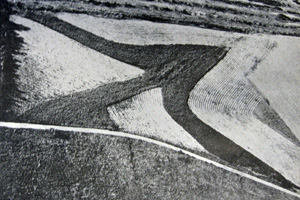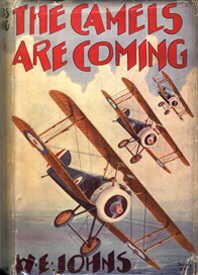A few weeks ago, I wrote about American fears in 1942 that German spies were making patterns in fields, as signals to the location of nearby targets of military significance. At the time, I had this feeling that I’d come across something very similar, but couldn’t quite place it. Now I’ve worked out what it was: the exact same thing happened in Britain late in the summer of 1940!
The following is from Midge Gillies’ book Waiting for Hitler, which I’ve discussed before. Her source is the memoir of Major H. R. V. Jordan, who commanded a counter-intelligence unit in the Western Command during the Second World War.
Anxiety that German airmen were being helped on the ground produced a phenomenon similar to the corn circles that appeared in Britain in the summer of 1990. Jordan dealt with several reports from RAF pilots: one had spotted what appeared to be a sign in the middle of a field of wheat that pointed to a nearby Royal Ordnance factory. It was about 150 feet long and seemed to grow more vivid each day. Jordan discovered that the farmer had sown wheat, then found some seed barley and, not wanting to waste it, drilled it down the middle of the field. As the two crops grew the barley appeared to point to the factory. Another pilot noticed that a field had been ploughed in such a way that a hammer and sickle was clearly visible. The farmer confessed that, far from harbouring Soviet sympathies, he had wanted to make his wife laugh. A third pilot became convinced that he could see a white arrow glinting in the sun. It seemed to grow every day, and seemed to point to ICI’s chemical factory, an important target for the Luftwaffe. A close investigation on the ground found that the ‘arrow’ was a granite path under construction in the ground of a sanatorium.1
The only difference between the American and the British cases is that, as far as I can see, the British spy markers never made the papers. This could be because British counter-intelligence was on the job where their American counterpart was not; but there was a suggestion in the American case that the publicity given to the claims there was because one Army PR officer was a little too eager to provide the press with a good story. I don’t know whether something like that could have happened in Britain in 1940 — my impression is that information flow from the various ministries was too tightly controlled for that, and I doubt anyone in authority wanted to encourage a spy panic. But I don’t know for sure.
The close similarity of the two marker scares suggests similar origins. They both took place relatively early in their respective country’s wars, so obviously there’s an element of war nerves, looking out for anything out of the ordinary which could mean danger. The so-called markers weren’t anything out of the ordinary (except for the hammer and sickle!), of course, except when seen from the air, where things look very different than they do from the ground. It’s just a guess, but I’d say that as both countries expanded their air forces in wartime, there were more inexperienced pilots flying over wider areas than there ever had been before, training and patrolling. But in places like the east coast of the United States or the west coast of Britain, there wasn’t a lot of enemy activity, if any. So bored pilots let their eyes drift downwards and misinterpreted ordinary rural practices as something more sinister.
![]() This work is licensed under a Creative Commons Attribution-NonCommercial-NoDerivatives 4.0 International License.
Permissions beyond the scope of this license may be available at http://airminded.org/copyright/.
This work is licensed under a Creative Commons Attribution-NonCommercial-NoDerivatives 4.0 International License.
Permissions beyond the scope of this license may be available at http://airminded.org/copyright/.
- Midge Gillies, Waiting for Hitler: Voices from Britain on the Brink of Invasion (London: Hodder & Stoughton, 2007), 247. [↩]





Something similar also happened in France/Belgium in May 1940, but things got nastier: scared British soldiers sometimes summarily executed farmers for supposedly making signs to help the Germans. See:
Glyn Prysor, ‘The ‘Fifth Column’ and the British Experience of Retreat, 1940’, War In History, 12 (2005), pp. 418-447.
Very nasty indeed — thanks for that. So it would seem that no airborne observers were involved there. I wonder if stories of these supposed markers in France came back to Britain with the BEF, and then passed to the RAF?
It seems like they’d heard rumours about secret signs and were so freaked out that they just assumed that anyone ploughing a field must be a fifth columnist. I wonder where the idea came from in the first place, but it could just be as bizarre and random as the parachuting nuns.
How familiar would the average BEF soldier have been with the rhythms of rural life? They would have been mostly city or town lads, I think. It might be easy for them to misinterpret activities they didn’t know much about, if they were already primed for suspicion.
In one direction I’m reminded of the German army’s fear of Belgian francs-tireurs in 1914 (Horne and Kramer, German Atrocities, 1914), in another, of the ‘great fear’ of 1789, when nervous townsfolk saw the clouds of dust from cattle etc being drive to market, and thought it was the noble/brigand alliance coming to get them (Lefebvre, The Great Fear of 1789).
Pingback: Major H. R. V. Jordan - WW2 Forum